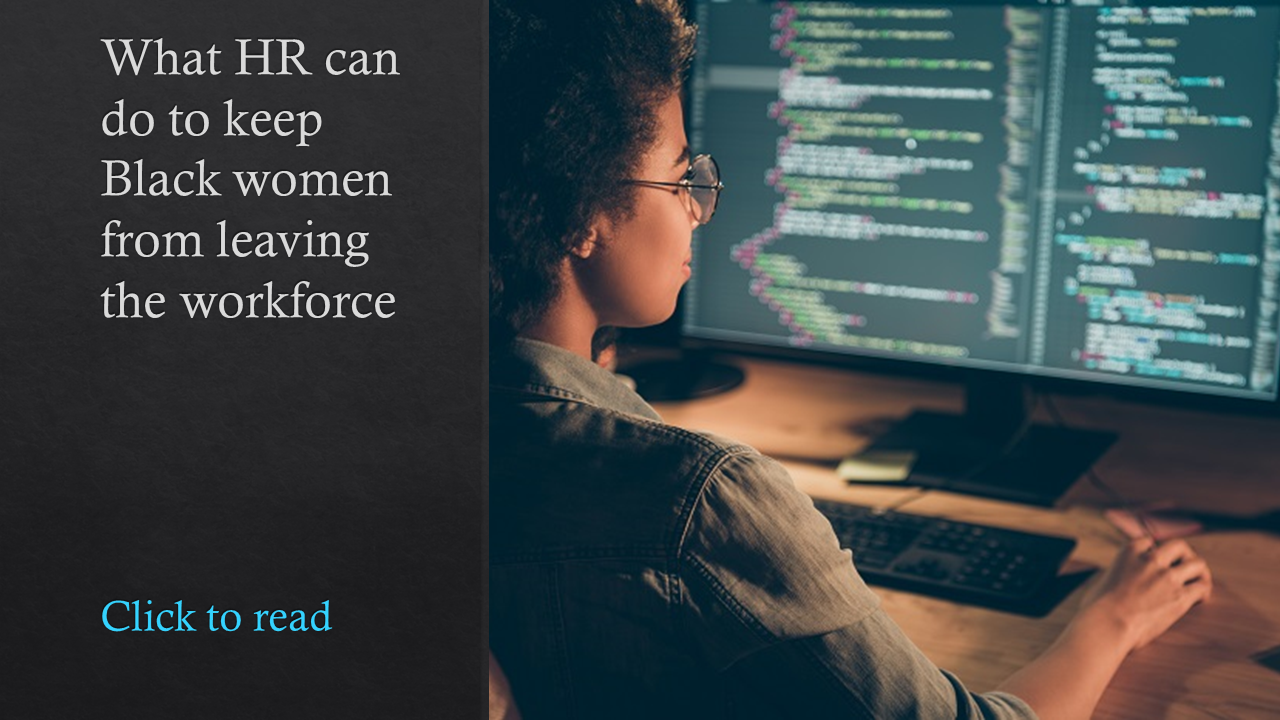She-cession. Pink Collar Recession. No matter what you call it, it’s happening.
The statistics are stark: More than 5 million payroll jobs held by women were lost in 2020. Of those women, nearly 2.5 million left the workforce entirely in the last year. Just in the month of December, women accounted for a stunning 100% of job losses. Women of color are reflected disproportionately in all of these numbers.
And it’s not letting up: A recent report from McKinsey found that women are 1.3 times more likely than men to consider leaving the workforce, with about one in four women on the brink.
The trend has turned back the clock on women’s labor force participation more than 30 years—but, despite the stunning turn, it’s not an entirely unforeseen crisis.
How we got here

Lexy Martin, Visier
There were a host of issues already at play that bubbled up to the surface once the pandemic started, says Lexy Martin, principal of research and customer value at Visier.
Also see: Working women are struggling: 4 ways HR leaders can help
Expectations that women are primary caregivers, women taking time off for motherhood during ages when workers may see promotions, male-oriented work cultures, performance assessments skewed toward in-office workers—“all of these factors cause frictions for women more than for men,” Martin says.
Layer in wider, male-dominated cultural norms that put the onus on mothers, when pandemic shutdowns started, to handle children’s remote schooling, shopping, cooking, cleaning and other household tasks, and the female turnover rates started ticking up. On top of that, the type of jobs more likely to be held by women—service-oriented positions such as teachers, childcare workers, social workers, often called “pink collar” jobs—were among the hardest-hit by closures.
A story in The Washington Post described that one out of four American women who became unemployed during the pandemic cited a lack of childcare—twice the rate of men who said childcare issues caused their job loss.
“The pandemic exacerbated the difficult choice women have had to make between paying for childcare or sacrificing their career to be a full-time caregiver,” says Star Carter, co-founder, chief operating officer and general counsel at diversity, equity and inclusion platform Kanarys. “As a mother myself of young, school-aged children, I’ve also felt the burden of childcare even before the pandemic, and now, I have had to adapt to juggling work, children’s schooling and other household needs all within the confines of my home.”
Many mothers were placed in untenable situations, said Abby Haynes, senior research associate at The Mom Project, a digital talent marketplace for women. Through research over the last year on the effect of the pandemic on working moms, Haynes says, the organization connected with many whose employers simply told them to “take a leave or step away from the workforce for a bit” if the new demands were too much.
Star Carter, Kanarys
On top of fears of their career stalling, many weren’t able to take a step back because they were the main or sole provider, she says, “and that resulted in a lot of families putting kids back in childcare earlier than they would have felt comfortable. They were forced into this tradeoff position.”
What women want
While numerous vaccines have put a potential end date on the pandemic, the impact on working women persists. Even among those who have been able to stay in their positions thus far, stress and burnout are driving up their status as flight risks; a recent report from accounting software firm Xero found that, while about half of employees without kids reported the pandemic has had an extremely or very negative impact on their mental health, that figured stood at 62% for parents. Research from Eagle Hill Consulting also painted a bleak picture, with more than one-third of parents surveyed saying they plan to leave their current job after the pandemic.
So, how can employers stem the tide and keep their working parents, particularly women?
It all comes back to flexibility.
A Perceptyx study recently found that nearly half of women have become either much less or somewhat less likely to want to return fulltime to the physical workplace, compared to six months ago. While about a quarter of both men and women reported to Perceptyx they preferred a hybrid arrangement, men said they would ideally work in-office three to four days, while women hoped to be there two to three days.
 Jana Galbraith, director of people experience at Xero, says her company has prioritized flexibility in the last year—allowing employees to work traditional hours, in blocks of time throughout the day and in the evening—and that has helped keep working mothers engaged and retained.
Jana Galbraith, director of people experience at Xero, says her company has prioritized flexibility in the last year—allowing employees to work traditional hours, in blocks of time throughout the day and in the evening—and that has helped keep working mothers engaged and retained.
That idea extends throughout the culture, she says.
“They know it’s OK to bow out of meetings or to turn off their cameras or to ask for help—there’s no scrutiny or judgment,” she says. “Over the past year, we’ve seen kids on laps during meetings and dogs jumping on desks, and that’s totally accepted—and welcomed. It gives people a lot of comfort that they don’t have to pretend there’s nothing going on in the background.”
Dr. Pam Cohen, chief research and analytics officer at The Mom Project and president of its research arm Werklabs, says the organization sees more companies reframing how they think about flexibility—and its consequences on women’s careers.
Dr. Pam Cohen, The Mom Project/WerkLabs
“For women, previously having some flexibility meant oftentimes that they were sidelined on opportunities or thought of as less of an employee. Even in places where flexibility had been encouraged before, it’s becoming more of the norm now,” Cohen says. However, as we get closer to some in-office work resuming, there is a risk for companies retreating back to traditional practices, she says.
Related Why women need to ‘shout those accomplishments’
“There needs to be a lot of effort taken on the part of companies to continue that trajectory [toward flexibility] and realize that, with some combination of in-office and remote work, they can really better support women who need flexible schedules—and that that doesn’t mean they can’t progress on the career ladder,” she says.
Many women who’ve worked with The Mom Project, Haynes says, have expressed a desire for more employer support in the way of mentorship and development opportunities. In particular, they want to feel like they can continue to further their career even if they’re not moving at lightspeed because of external conditions.
“It’s a difficult time to push the pedal to the metal; a lot of moms just don’t feel like they have the capacity to do that right now. They need to press pause in order to manage work and home dynamics,” she says, noting that employers shouldn’t view a step back as a step down. “There are times in your career where you can jog or run or sprint—and a lot of moms feel that right now is a time to just walk.”
‘From challenge comes change’
While employers should be focused on retaining their female talent, they also need to think about inviting back those who’ve left in the last year.
 Hybrid setups, enhanced flexibility and strong leave plans are good tools to attract new female employees, but organizations also need to communicate transparently about expectations—from recruiting to onboarding and throughout the employee lifecycle, Cohen says.
Hybrid setups, enhanced flexibility and strong leave plans are good tools to attract new female employees, but organizations also need to communicate transparently about expectations—from recruiting to onboarding and throughout the employee lifecycle, Cohen says.
“We hear all the time that women simply won’t try to reenter the workforce until they know they’ll have a flexible schedule and be supported and that they can make it all work,” she says. “If they’re coming back to work parttime versus fulltime, they need the full assurance of the company that 20 hours means 20 hours. And they need to be told along the way, ‘We want to retain you for the long haul so we’re willing to work with you.’ That’s a huge step toward luring women back.”
Rooting out unconscious bias and systemic barriers—particularly those faced by women of color—also needs to be part of the strategy, says Whitney Benner, chief people officer at real-time information discovery platform Dataminr.
“There is no one solution for the macroeconomic factors that contribute to this dilemma, but HR teams can start with combating structural sexism and developing equitable benefits and support for all working parents,” she says. “We cannot make meaningful progress until we acknowledge that we need to ‘level the playing field’ and lift everyone up. Only then can we all collectively thrive and reach our full potential.”
REGISTER Health and Benefits Leadership Conference (it’s FREE and VIRTUAL)
That was among the aims of this month’s International Women’s Day, the theme of which encapsulated the new environment facing many working mothers, and their employers: “A challenged world is an alert world, and from challenge comes change.”
 Consulting firm Accenture is looking to transform the challenges of the last year into innovation with a new program announced last month in which it will hire 150 mothers for technology, strategy and consulting jobs in its Midwest division. Flexibility—along with mentorship and development opportunities—will be key to the positions.
Consulting firm Accenture is looking to transform the challenges of the last year into innovation with a new program announced last month in which it will hire 150 mothers for technology, strategy and consulting jobs in its Midwest division. Flexibility—along with mentorship and development opportunities—will be key to the positions.
“With more than 5 million women being forced to leave the workforce due to the pandemic,” says Allison Robinson, founder and CEO of The Mom Project, “it’s critical that companies step up and follow through. It’s not just ‘nice,’ it’s a business and economic imperative that will propel organizations forward.”
Also see Workplace diversity: Is HR doing enough?
While organizational actions like Accenture’s could encourage other companies to follow suit, there are other causes for optimism, Cohen says: from the number of employers that have announced permanent remote policies to a federal administration that has pledged support for working women to increasing cognizance on the part of company leadership about the value of diversity.
“It’s not going to work anymore to just have a homogenous group thinking together,” Cohen says. “Companies are realizing they need fresh ideas and energy and you have to accommodate women, and especially women of color, to do that—and, if you can, you’ll be far better off.”